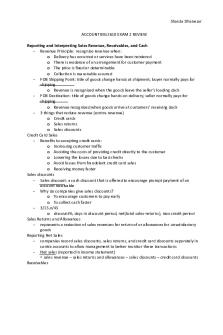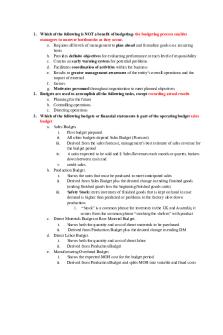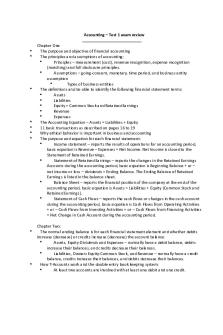Accounting Exam 2 Review PDF

| Title | Accounting Exam 2 Review |
|---|---|
| Course | Intro To Managerial Accounting |
| Institution | Lamar University |
| Pages | 17 |
| File Size | 1.1 MB |
| File Type | |
| Total Downloads | 25 |
| Total Views | 186 |
Summary
Download Accounting Exam 2 Review PDF
Description
10/26/17 Accounting Exam 2 Review (mainly tested on formulas) Chapter 4: 8 Questions Chapter 5: 13 Questions Chapter 6: 4 Questions
Chapter 4: 1. What is the journal entry to record application of manufacturing overhead to work in process in a process costing system with two departments? (Straight from slides)
2. How do we calculate the equivalent units under the weighted average method of process costing? (Know step by step, formula on board) Determine equivalent units of production, compute cost per equivalent unit, assign costs to units, check work with reconciliation report.
10/26/17 3. What type of businesses use process costing opposed to job costing? Used for mass production of similar products. Process costing is used for similar products being produced continuously. Process costing: 1. Is used when a single product is produced on a continuing basis or for a long period of time. Job-order costing is used when many different jobs having different production requirements are worked on each period. 2. Systems accumulate costs by department. Job-order costing systems accumulated costs by individual jobs. 3. Systems compute unit costs by department. Job-order costing systems compute unit costs by job on the job cost sheet.
4. Beginning inventory, work in progress, units transferred in. Calculate units transferred to the next department. Schedule of cost of goods manufacturing (from slides)
10/26/17 5. Calculating equivalent units with respect to conversion or material costs under the weighted average method (step 1 out of 4 in process) (Ex. 4-2, pg. 180)
10/26/17 6. Calculate cost per equivalent unit given all of relative information (Step 2) (Exercise 4-3)
10/26/17
10/26/17 7. Given: cost per equivalent unit for materials and conversion costs. What is total cost of units completed and transferred out of the department? (Step 3) (Exercise 4-4)
8. Know the journal entry to transfer goods between processing departments (simple journal entry) and to transfer those goods to finished goods (listed right on slides).
10/26/17
Finished Goods
XXXXX
Work in Process - Department B
XXXXX
Chapter 5: 9. What is contribution margin? The amount remaining from sales revenue after variable expenses have been deducted. This is the amount available to cover fixed expenses and then to provide profit for the period. CM Ratio = contribution margin/sales 10. What is margin of safety? The excess of budgeted or actual sales dollars over the breakeven volume of sales dollars. It is the amount by which sales can drop before losses are incurred.
11. Given: contribution format statement and data present on statement. With a certain level of sales and units, what is the total contribution margin?
10/26/17
12. Given the same information as above… what is the new net operating income? Net income = sales – variable expenses – fixed expenses 13. Calculate unit contribution margin. (formula) Unit contribution margin = CM ratio * unit selling price 14. Calculate net operating income given a contribution margin ratio, fixed expenses, and sales. (Sales * CMR) – Fixed Expenses
Total unit sales................ Sales.............................. Contribution margin ratio. Contribution margin......... Fixed expenses............... Net operating income......
50,000 $200,000 0.40 80,000 65,000 $ 15,000
15. Calculate the level of sales given a certain degree of operating leverage.
Exerc Exercise ise 5-9 (20 minutes)
10/26/17
1. The company’s degree of operating leverage would be computed as follows: Contribution margin (a)........................... Net operating income (b)........................ Degree of operating leverage (a) ÷ (b)....
$48,000 $10,000 4.8
2. A 5% increase in sales should result in a 24% increase in net operating income, computed as follows: Degree of operating leverage (a)........................................... Percent increase in sales (b).................................................. Estimated percent increase in net operating income (a) × (b)..
4.8 5% 24%
16. Calculate break-even unit sales given P (selling price per unit), V (Variable Expense Per Unit), and FE (Fixed Expenses) 17. Calculate break-even point in dollar sales, given P, V, and Fixed Expenses. (For #16 and #17) Mauro Products distributes a single product, a woven basket whose selling price is $15 and whose variable expense is $12 per unit. The company’s monthly fixed expense is $4,200. a. Solve for the company’s break-even point in unit sales.
Unit sales to break even = =
Fixed expenses Unit CM $4,200 = 1,400 baskets $3
b. Solve for the company’s break-even point in dollar sales.
10/26/17
Dollar sales to break even = =
Fixed expenses CM ratio $4,200 = $21,000 0.20
18. Calculate target profit in sales dollars (2 methods). Profit = CM ratio × Sales – Fixed expenses 19. Calculate target profit in unit sales (2 methods). Profit = Unit CM × Q – Fixed expenses
20. Calculate margin of safety in dollars. Margin of safety in dollars = Total sales - Break-even sales
21. Know formula for break-even point in units Break-even point in units = Fixed Expenses/Unit CM Chapter 6: 22.
10/26/17
23. Know what the period and product costs are for absorption and variable costs (at beginning of slide)
10/26/17
24. Know what’s on the income statement (components) for absorption (Traditional) and variable (Contribution) costs.
10/26/17
10/26/17
10/26/17
10/26/17 25. Know how to calculate break-even point for both parent company and segments of that company (on slides).
10/26/17...
Similar Free PDFs

Accounting Exam 2 Review
- 10 Pages

Accounting Exam 2 Review
- 17 Pages

Accounting Exam 2 Review
- 8 Pages

Accounting Exam 1 Review
- 3 Pages

Accounting 1 Exam 2 Review notes
- 21 Pages

Accounting 1 Final Exam Review
- 15 Pages

Accounting – Test 1 exam review
- 2 Pages

Accounting 201 Exam 1 Review
- 3 Pages

Financial accounting exam 2
- 16 Pages

ECON1010 EXAM 2 Review
- 2 Pages

Exam 2 Review
- 11 Pages

Exam 2 review notes
- 4 Pages

Exam 2 Review
- 6 Pages

Exam 2 Review Sheet
- 3 Pages

Exam 2 Review Session
- 5 Pages
Popular Institutions
- Tinajero National High School - Annex
- Politeknik Caltex Riau
- Yokohama City University
- SGT University
- University of Al-Qadisiyah
- Divine Word College of Vigan
- Techniek College Rotterdam
- Universidade de Santiago
- Universiti Teknologi MARA Cawangan Johor Kampus Pasir Gudang
- Poltekkes Kemenkes Yogyakarta
- Baguio City National High School
- Colegio san marcos
- preparatoria uno
- Centro de Bachillerato Tecnológico Industrial y de Servicios No. 107
- Dalian Maritime University
- Quang Trung Secondary School
- Colegio Tecnológico en Informática
- Corporación Regional de Educación Superior
- Grupo CEDVA
- Dar Al Uloom University
- Centro de Estudios Preuniversitarios de la Universidad Nacional de Ingeniería
- 上智大学
- Aakash International School, Nuna Majara
- San Felipe Neri Catholic School
- Kang Chiao International School - New Taipei City
- Misamis Occidental National High School
- Institución Educativa Escuela Normal Juan Ladrilleros
- Kolehiyo ng Pantukan
- Batanes State College
- Instituto Continental
- Sekolah Menengah Kejuruan Kesehatan Kaltara (Tarakan)
- Colegio de La Inmaculada Concepcion - Cebu
